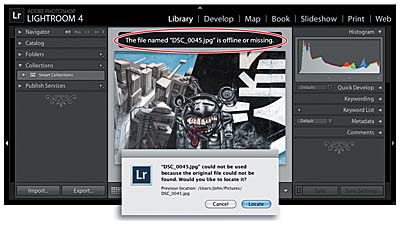A Quick Tour of Adobe Photoshop Lightroom 4
- 1. A Quick Tour of Photoshop Lightroom
- The Lightroom workspace
- The Lightroom modules
- The Lightroom workflow
- Developing and editing
- Sharing your work by e-mail
Note: This excerpt does not include the lesson files. The lesson files are available with purchase of the book.
Lesson overview
The first part of this lesson will help you understand how Lightroom works and familiarize you with the workspace, providing an introduction to the seven Lightroom workspace modules:
- The Library Module, where you’ll import, review, and organize your images so that you can access them quickly and easily
- The Map Module, where you can make use of GPS information recorded by your camera to help manage your photos
- The Develop Module, a digital darkroom where you can correct, adjust, retouch, and enhance your photos
- The Book Module, where it’s easy to produce stylish photo books
- The Slideshow Module, where you can quickly create dynamic, expressive presentations to showcase your work
- The Print Module, where you can quickly set up professional-looking print layouts and manage output settings with ease
- The Web Module, where you’ll find everything you need to share your photos in your own interactive web gallery
The exercises in the second part of the lesson will guide you through a typical workflow: you’ll import, review, organize, and edit images, and then share them as e-mail attachments.
You’ll probably need between one and two hours to complete this lesson.
In this lesson, you’ll get an overview of how Lightroom works. You’ll familiarize yourself with the workspace, panels, tools, and controls, as you explore the Library, Develop, Map, Book, Slideshow, Print and Web Modules.
Understanding how Lightroom works
Working with Lightroom will be easier and more productive if you have an overview of how Lightroom works—and how it differs from other image processing applications in the way it handles digital images.
About catalog files
Lightroom stores information about your images in a catalog file. The catalog file is central to the way Lightroom works: when you bring a photo into your library, Lightroom does not actually import the image file itself but merely creates a new entry in the library catalog to record the file’s location. Once an image has been registered in this way as part of your Lightroom library, any operation you perform on the photo in Lightroom will be recorded in its catalog entry. Whenever you assign a rating, tag, or flag to the image, group it in a collection with other photos, or publish it online, your actions are recorded in the catalog file.
The images in your Lightroom library can be located anywhere on your computer hard disk, or even on external storage media; the catalog file stores references to their locations. If you wish to rename or move an image file that you’ve already imported into your library, you should only do so from within Lightroom so that the changes can be tracked by the catalog file; otherwise, Lightroom will report the renamed or moved file as missing and you’ll be asked to reestablish the link so that the information in the catalog file can be updated.
Managing photos in a library
To work with a photo in Lightroom you must first add it to your library catalog by importing it from your computer hard disk or from external storage media, or by downloading it directly from a digital camera or card reader.
Even during the import process, Lightroom offers you a range of options to help you manage your photos. The intuitive import interface (see the illustration below) makes it quick and easy to set up your own import presets that will save you time and effort by batch-processing your image files as they are imported.
You can choose to leave your image files at their current locations, copy them to a new location leaving the originals intact (the option illustrated below), or move them and delete the originals to avoid duplicating files. If you choose to copy or move your files during the import process, you can either have Lightroom replicate the original folder structure in which they are stored, reorganize them into subfolders based on capture date, or consolidate them into a single folder.
You can also have Lightroom rename your image files during import, create duplicates for backup purposes, attach keyword tags and other metadata, and even apply a wide range of developing presets—all before you’ve opened a single image! You’ll learn more about the import options in Lesson 3, “Importing.”
Non-destructive editing
The catalog file also records each step you take when you modify or edit a photo. When you crop the image, correct the color, adjust exposure, or apply effects, Lightroom writes the changes to the photo’s library catalog entry—effectively saving a set of instructions for the edits you make—rather than applying the changes directly to the original image file. This is called non-destructive editing.
As you work on your photo, Lightroom will show you a preview of the effects of your work, but the original image actually remains unaltered. The modifications you make are applied only when you export or output the image. In this respect, Lightroom works very differently from image processing applications such as Photoshop or Photoshop Elements, which save changes directly to the source file.
There are many advantages in storing modifications separately from the image data. Non-destructive editing frees you to experiment with your images. Crop an image and later change your mind—no problem! You can undo, redo, or tweak any modification that you’ve made without ever losing any information from the original file.
The changes you make to an image will be applied only during output—while it is being exported as a preview to be displayed on-screen in Lightroom, as part of a print or book layout, or as a low-resolution JPEG image to be used in a web page. The original image data remains intact; the editing instructions captured in the catalog file are applied only to copies of the image created in the rendering process.
Should you wish to edit an image using an external image processing application, you should always launch the process from within Lightroom. In this way, you can be sure that Lightroom will keep track of changes made to the file, and the edited copy will automatically be added to your Lightroom library. For a JPEG, TIFF, or PSD image, Lightroom gives you the option to edit the original file, or a copy—either with or without the adjustments that you’ve already applied in Lightroom. For files in any other file format, you can edit a copy to which your Lightroom adjustments have already been applied.


